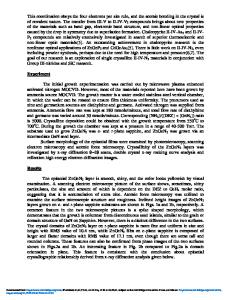Epitaxial Growth and Structural Characterization of Single Crystalline ZnGeN 2
- PDF / 3,620,682 Bytes
- 6 Pages / 417.6 x 639 pts Page_size
- 6 Downloads / 363 Views
as well as epitaxial lateral over growth. Compared to the conventional Ill-V semiconductors, Group III-nitrides system has some inherent limitations. In Group III-arsenides and phosphides, there are choices to construct lattice matched dissimilar band gap heterostructures to design various optoelectronic and electronic devices with excellent crystal quality. However, lattice mismatch between GaN and AIN, GaN and InN is as large as 2.4% and 11.3%, respectively. The large mismatch forces the use of low Al composition A1GaN, which causes carrier overflow in GaN/AIGaN heterojunctions. Increasing Al composition results in cracking of the AlGaN layer beside the increased resistivity. The situation in InGaN seems even more serious. The huge atomic size differences are the cause of instability in the alloy and results in phase separation. This fact limits utility of InGaN for use in photonic devices with longer wavelengths beyond green as well as other devices requiring high In composition or thick InGaN layers. Another limiting factor in GaN/AlGaN system is the low p-type conductivity. Resistivity of p-GaN is around 0.2 Q-cm, and it is higher for p-AlGaN. This is a heating source as well as origin of parasitic RC time constant in high power laser diodes and HBTs. To explore the potential of wide band gap semiconductors with a broad horizon, we noticed a set of nitride semiconductors which can be expressed as II-IV-N 2 compound system. Early in1957 Goodman pointed out that by ordered substitution of Group 1] and Group IV atoms for the Group III atoms in the III-V compounds a new ordered semiconducting II-IV-V 2 compounds could be prepared[4]. Crystallographically, this set of compounds evolves from the tetrahedral diamond structure with the Group V atom surrounded by two Group II and two G 3.8 Mat. Res. Soc. Symp. Proc. Vol. 537 @1999 Materials Research Society
Group IV atoms and the Group II or IV atom surrounded by four Group V atoms tetrahedrally. This coordination obeys the four electrons per site rule, and the atomic bonding in the crystal is of covalent nature. The transfer from III-V to II-IV-V 2 compounds brings about new properties of the materials such as band gap, electronic band structure, and non-linear optical properties caused by the drop in symmetry due to superlattice formation. Chalcopyrite II-IV-As 2 and II-IVP2 compounds are relatively extensively investigated in search of superior thermoelectric and non-linear optic materials[5]. An outstanding achievement in chalcopyrite research is the nonlinear optical applications of ZnGeP 2 and CdGeAs 2[5]. There is little work on Il-IV-N 2, even including powder synthesis, perhaps due to the need for high temperature and pressure[6,7]. The goal of our research is an exploration of single crystalline II-IV-N 2 materials in conjunction with Group III-nitrides and SiC research. Experiment The initial growth experimentation was carried out by microwave plasma enhanced activated nitrogen MOCVD. However, most of the materials reported here have been grown by ammonia s
Data Loading...











